Going Viral: Share These Books About Infectious Diseases and Vaccines
Children's and YA titles are vital resources in public health education.
Just when it seemed COVID-19 was receding in the rearview window, we’re facing new threats like bird flu. At the same time, older infectious diseases and efforts to combat them are back in the news, with a concerning rise in cases of measles, tuberculosis, and pertussis in the U.S. and elsewhere.
School library collections play a key role in science education for children and their families. This selection of stellar titles will engage and inform children and teens, as well as the adults who read with them. The books here impart scientific knowledge in creative ways and offer inspiring stories of medical heroes and heroines and memorable reading experiences.
Although this list uses grade levels, there’s always a place for great picture books in middle or high school libraries to complement longer texts. And if you can only add one title, you can’t go wrong with Rajani LaRocca and Kathleen Marcotte’s A Vaccine Is Like a Memory with its exemplary back matter and its reassuring refrain: “A vaccine is like a memory of a disease you never had.”
ANDERSON, Laurie Halse. Fever 1793. S. & S. 2000. ISBN 9780689838583.
Gr 4-9–Laurie Halse Anderson takes readers into the heart of a 1793 yellow fever outbreak in Philadelphia in her compelling historical fiction novel about 14-year-old Mattie and her struggle to survive and make a future for herself. Mattie is aided by Eliza, a formerly enslaved woman who helps Mattie re-open her mother’s coffee house. Yellow fever, which is spread by mosquitoes, is endemic in more than 30 countries in Africa and can be prevented by a vaccine.
BAUSUM, Ann. VIRAL: The Fight Against AIDS in America.Viking. 2019. ISBN 9780425287200.
Gr 7 Up–In this follow-up to Bausum’s YALSA 2016 nonfiction finalist, Stonewall: Breaking Out in the Fight for Gay Rights, the acclaimed nonfiction author recounts the history of the AIDS epidemic in the United States. The book is divided into three chronological sections (“Contagion 1969–1983”; “Catastrophe 1983–1992”; and “Control 1992–Today”). Bausum brings to this important story her impeccable research skills as well as an ability to highlight personal stories while also conveying the historical and social context of the time.
BROOKS, Geraldine. Year of Wonders.Penguin. 2002. ISBN 9780142001431.
Gr 9 Up–Yes, this novel was written for adults. But it works splendidly for YA readers. Pulitzer Prize-winning author Brooks has crafted an intense, immersive reading experience with a strong female character who emerges as a leader of a community in crisis. Set in 1666 and inspired by the story of an English village that isolated itself during the plague, Year of Wonders is an unforgettable tale of what happens when fear disrupts the bonds that hold a society together.
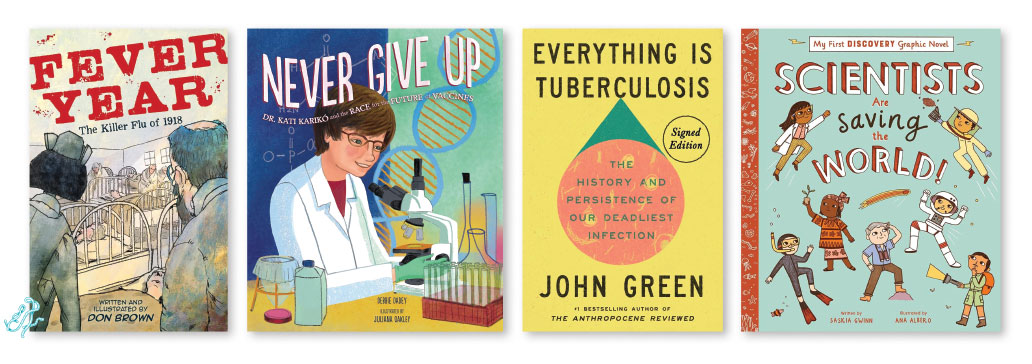
BROWN, Don. Fever Year: The Killer Flu of 1918.Clarion. 2019. ISBN 9780544837409.
Gr 6-8–Sibert Honor–winning Brown creates an unputdownable nonfiction graphic account of the 1918 influenza pandemic. It’s hard to overestimate the global impact of this flu, which spread rapidly and killed young and old alike, often in mere hours. Brown’s heartbreaking artwork effectively captures the ways in which the disease ravaged American families. The account includes source notes and a bibliography for further reading.
DADEY, Debbie. Never Give Up: Dr. Kati Karikó and the Race for the Future of Vaccines. illus. by Juliana Oakley. Millbrook. 2023. ISBN 9781728456331.
K-Gr 4–Along with relating the story of Karikó’s remarkable life and research, Dadey and Oakley’s nonfiction biography features substantive back matter, including several photographs of the scientist as a baby, as well as with her fellow 2023 Nobel recipient, Dr. Drew Weissman. One strong and especially timely feature is the inclusion of graphics that illustrate the steps involved in making a vaccine and the stages vaccines must go through before they are given to the public.
GREEN, John. Everything is Tuberculosis: The History and Persistence of Our Deadliest Infection. Crash Course Bks. 2025. ISBN 9780525426059.
Gr 9 Up–While published as adult nonfiction, Green’s riveting new book will have immense appeal for high school and even middle school readers. Green uses the same clear prose and compassionate storytelling that mark his YA fiction to illuminate the history and current status of an infectious disease that disproportionately affects people in developing countries. Green’s interest was sparked by a 2019 meeting with a young tuberculosis patient in Sierra Leone named Henry Reider, whose struggles with the disease form the heart of the book. This is a timely addition for high school and public libraries.
GWINN, Saskia. Scientists Are Saving the World! illus. by Ana Albero. Magic Cat. 2023. ISBN 9781419765964.
K-Gr 4–It’s not easy to imagine a career in the sciences if you aren’t sure what scientists do. This short, informational graphic text expands readers’ awareness of scientific fields. Framed as a conversation between a kid and his mom, the book presents simple definitions and introduces famous figures, including Mary Anning, Wangari Maathai, and Sir David Attenborough. One strength is the inclusion of scientists who may not be household names, such as Rachel Schneerson, who was credited with developing a vaccine for bacterial meningitis, and German immunologist Ugur Sahin, co-founder of BioNTech.
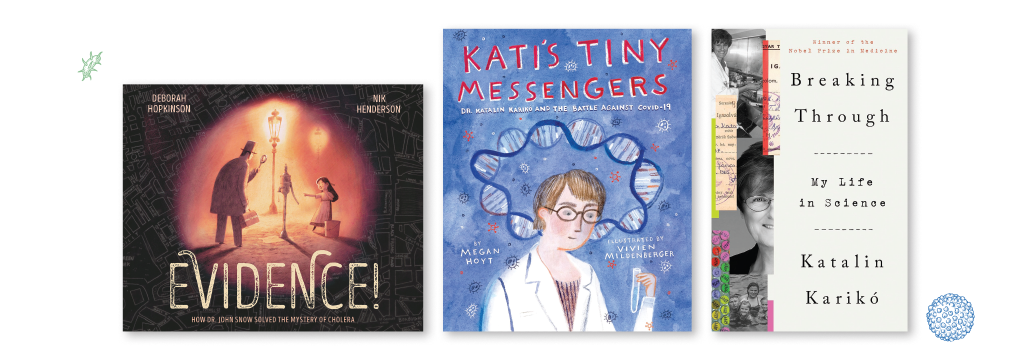
HOPKINSON, Deborah. Evidence! How Dr. John Snow Solved the Mystery of Cholera. illus. by Nik Henderson. Knopf. 2024. ISBN 9780593426814.
Gr 1-5–Here I write about Dr. John Snow (1813–1858), who is widely regarded as the father of modern epidemiology, due to his dogged efforts to prove that cholera was spread by water during the 1854 cholera outbreak in London. Nik Henderson’s sepia illustrations capture the uncertainty and looming menace of the time. The removal of the handle of the Broad Street pump to prevent the community from drinking water from the well beneath helped usher in modern public health efforts.
HOYT, Megan. Kati’s Tiny Messengers: Dr. Katalin Karikó and the Battle Against COVID-19. illus. by Vivien Mildenberger. Quill Tree/HarperCollins. 2023. ISBN 9780063216624.
K-Gr 4–Nobel Prize recipient Dr. Katalin Karikó may not (yet) be a household name, but she certainly should be, and this nonfiction picture book biography provides an excellent introduction to her life and work. Enhanced by Mildenberger’s lovely illustrations, Hoyt’s book traces the scientist’s journey from Hungary through her years of struggle to obtain support for her research on messenger RNA (mRNA) vaccine theory, which ultimately made the rapid development of a COVID-19 vaccine possible. Facts are integrated into the design in creative ways. Back matter includes an author’s note, timeline, and sources.
KARIKÓ, Katalin. Breaking Through: My Life in Science.Crown. 2024. ISBN 9780593443187.
Gr 7 Up–There’s a simple reason Katalin Karikó appears several times on this list: the determined scientist’s discovery of the medical potential of mRNA for vaccines is truly groundbreaking and has already impacted the lives of most people on the planet. Her riveting, accessible 2024 memoir will capture middle and high school readers (and adults). At the start, Karikó notes that her memoir is a thank you to those teachers and colleagues who supported her in her long and challenge-filled journey. The world marveled at the swift development of COVID-19 vaccines; here, readers see the many years of struggle that made those vaccines possible.
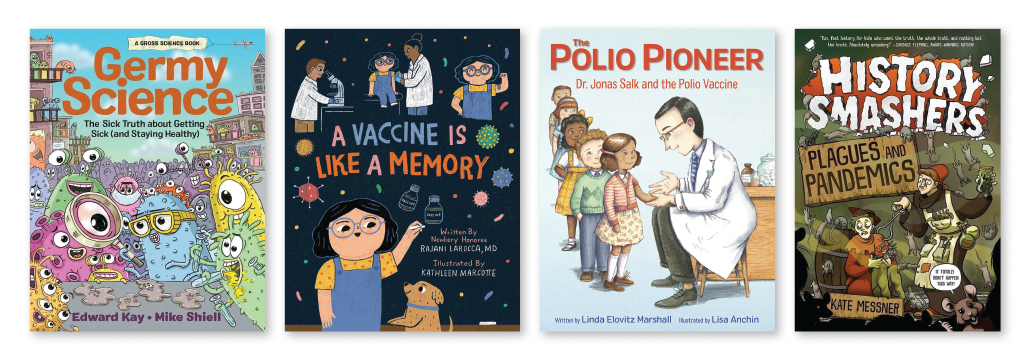
KAY, Edward. Germy Science: The Sick Truth About Getting Sick (and Staying Healthy). illus. by Mike Shiell. Kids Can. 2021. ISBN 9781525304125.
Gr 3-7–This entry in the “Gross Science” series combines humorous cartoon-like illustrations with a conversational text, making it a good choice for upper elementary and middle school students. Along with including miscellaneous fun facts, Kay isn’t shy about providing some of the disgusting details kids love. The story gets right into it, with an introduction that tells readers the book they’re holding is covered in germs. An appealing combination of humor, science, and history.
LAROCCA, Rajani. A Vaccine is Like a Memory. illus. by Kathleen Marcotte. little bee. 2023. ISBN 9781499813265.
K-Gr 6 Up–This marvelous introduction to vaccines is a must-have in elementary school libraries (and useful for older readers). Newbery Honor author LaRocca is also a practicing physician, with a gift for clear, concise explanations. Her text covers the history of the field, from the use of inoculation to treat smallpox to new developments in mRNA vaccine delivery. Marcotte’s bright palette portrays a diverse array of children and adults, while the back matter includes common diseases for which we have vaccines as well as a section on the various types of vaccines.
MARSHALL, Linda Elovitz. The Polio Pioneer: Dr. Jonas Salk and the Polio Vaccine. illus. by Lisa Anchin. Knopf. 2020. ISBN 9780525646518.
PreS-Gr 4–This nonfiction picture book biography traces the career and accomplishments of Dr. Jonas Salk (1914–1995), who grew up in New York City as the child of immigrant parents. As a young boy, Salk lived through the 1918 flu pandemic and went on to work with Dr. Thomas Francis, Jr. on a vaccine for flu. Salk then turned his attention to polio; by the early 1950s, there were as many as 50,000 new cases of polio each year. The polio vaccine campaign is remarkable for the involvement of nearly two million children who received the vaccine as “polio pioneers.” Illustrations show a diversity of children and adults.
MESSNER, Kate. History Smashers: Plagues and Pandemics. Illus. by Falynn Koch. Random. 2021. ISBN 9780593120415.
Gr 3-7–This entry in Messner’s popular “History Smashers” series is perfect for readers who love accumulating facts and are fascinated by disasters and the history of diseases. With a conversational style and a wealth of illustrations and informational sidebars, the engaging narrative covers a range of diseases, including bubonic plague, smallpox, cholera, and polio. Plagues and Pandemics is designed to both entertain and educate young readers—as only Messner can.
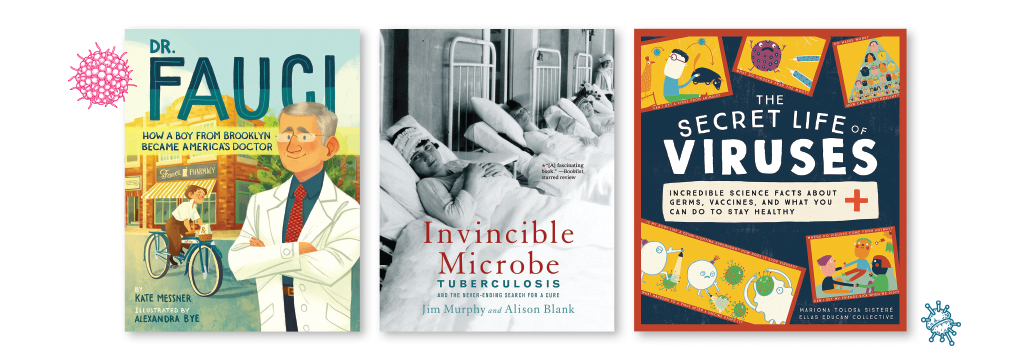
MESSNER, Kate. Dr. Fauci: How a Boy from Brooklyn Became America’s Doctor. illus. by Alexandra Bye. S. & S. 2021. ISBN 9781665902434.
Gr 1-4–This picture book biography of Fauci can be paired with Messner’s Plagues and Pandemics above. The title takes readers from Fauci’s Brooklyn childhood to medical school to director of the National Institute of Allergy and Infectious Diseases, working with seven U.S. presidents to take on some of the biggest public health challenges of the past 50 years.
MURPHY, Jim & Alison Blank. Invincible Microbe: Tuberculosis and the Never-Ending Search for a Cure. HarperCollins/Clarion. 2015. ISBN 9780544455948.
Gr 4-8–A complement to Green’s new book (p. 39), Murphy and Blank trace the history of tuberculosis, which has been with humans for millions of years, and, unlike smallpox, continues to kill people around the globe. Published in 2015, the text doesn’t include the most recent developments in the ongoing struggle to control TB. However, the late Jim Murphy was renowned for exceptional research and compelling narratives, and this book provides an excellent overview and wonderful source notes for readers who wish to learn more.
SISTERÉ, Mariona Tolosa & the Ellas Educan Collective. The Secret Life of Viruses: Incredible Science Facts About Germs, Vaccines, and What You Can Do To Stay Healthy. Sourcebooks/eXplore. 2021. ISBN 9781728239767.
PreS-Gr 4–This timely graphic translation, released during the COVID-19 pandemic, is a collaboration between Barcelona illustrator Mariona Tolosa Sisteré and a cohort of six female scientists in Spain. The result is a child-friendly introduction to viruses in a humorous, hybrid format (the narrator is a virus who addresses the reader and dispenses information and advice). Readers find out, for example, that “one gram of your poop can contain a billion viruses.” The book includes a lively cartoon-like layout showing how viruses spread. Illustrations of children and adults depict a range of skin colors. There’s also a helpful “catalog” of viruses and a fun true or false quiz at the end.
Children’s and middle grade author Deborah Hopkinson has written several books about science, public health, and diseases.
RELATED
The job outlook in 2030: Librarians will be in demand
The job outlook in 2030: Librarians will be in demand
ALREADY A SUBSCRIBER? LOG IN
We are currently offering this content for free. Sign up now to activate your personal profile, where you can save articles for future viewing


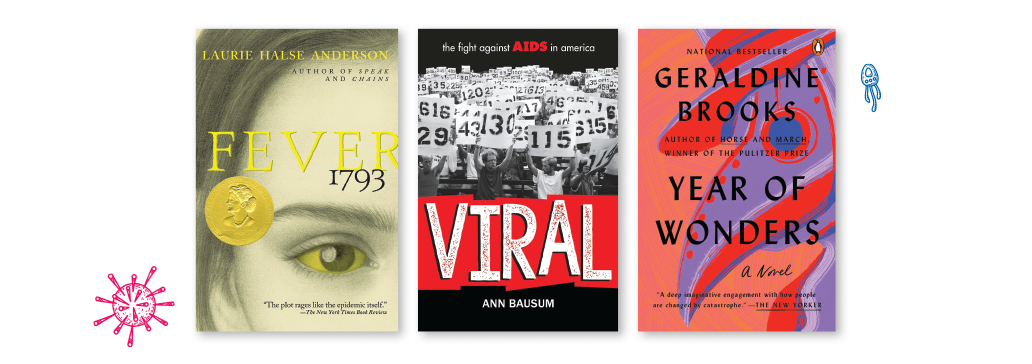




Add Comment :-
Be the first reader to comment.
Comment Policy:
Comment should not be empty !!!